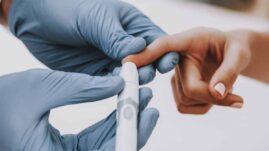People who live with diabetes know that to manage their condition properly, they need to balance both the highs (hyperglycemia) and lows (hypoglycemia) of the disease.
However, they often hear the words “diabetic coma” without ever getting a proper definition of what that means for their life.
Many people think that the risk of falling into a diabetic coma is low and only affects people with uncontrolled diabetes—this is not true.
This article will outline what a diabetic coma is, the causes of diabetic comas, the risks, how it’s treated, and what you can do to help prevent it.

What are the different types of diabetic coma?
Technically, there are three types of diabetic coma:
- Diabetic ketoacidosis( DKA) induced coma: Resulting from high blood sugar (hyperglycemia.)
- Hypoglycemic coma or “diabetic shock”: Resulting from low blood sugar ( hypoglycemia.)
- Hyperosmolar coma: Mostly affects people with type 2 diabetes.
People with type 1 diabetes usually suffer from the first two types of diabetic coma.
Diabetic coma, while rare, is extremely dangerous. People suffering from diabetic coma will be unresponsive and need immediate medical intervention to prevent death.
Diabetic ketoacidosis (DKA) induced coma
Diabetic ketoacidosis (DKA) is a serious complication of diabetes that occurs when the body’s blood turns acidic from an abundance of ketones in the blood.
This often happens from severely high blood sugar and a complete lack of insulin in the body.
This is why it usually happens to people with type 1 diabetes. It will often occur at diagnosis. About 25% of people are in DKA when they’re diagnosed with type 1 diabetes.
DKA is a medical emergency and requires immediate attention—including receiving insulin and fluids at a hospital. It can quickly develop into a coma without proper medical care.
DKA can occur quite quickly due to incidents such as insulin pump failures, being ill, suffering from an uncontrolled infection, or forgetting to take a meal insulin bolus.
It can progress over the course of several days, such as when someone is using expired insulin or if they are rationing their insulin.
DKA can also happen to people without diabetes. The condition can be caused by starvation, fasting (like intermittent fasting), alcoholism, and hyperthyroidism.
However, the vast majority of cases occur in people with insulin-dependent diabetes.
Symptoms of DKA
The following are typical symptoms of DKA. Seek immediate medical attention if you or a loved one are experiencing any of these symptoms.
- High blood sugar
- Ketones in the urine
- Dry mouth
- Shortness of breath
- Rapid heart rate
- Fruity smelling breath
- Extreme thirst
- Bodyache and headache
- Blurred vision
- Frequent urination
- Nausea
- Vomiting
- Extreme fatigue
- Confusion
- Sudden weight loss
- Flushing of the face
Be aware if you’re experiencing these symptoms and stubborn high blood sugar with moderate to high ketones for several hours, and insulin is not helping. You can fall into a DKA-induced coma very quickly.
I remember the day before I went to the hospital, I was incredibly thirsty and nauseous. The next morning, I couldn’t keep anything down and that’s when I knew I needed to go to the hospital.
Ty Beringer (you can read Ty’s DKA story here)
Treatment of DKA
DKA and DKA-induced coma require immediate medical attention. This will usually involve an intravenous insulin drip and fluids administered in a hospital setting.
Medical professionals will want to closely monitor your blood sugars and other vitals such as heart rate, temperature, kidney function, electrolyte levels, blood pressure, and urine levels.
Some cases of DKA require a stay in the intensive care unit (ICU), and many people spend upwards of a week recovering.
Seek immediate medical attention if you experience any of the above symptoms, along with high blood sugar (>250 mg/dL) and moderate to high ketones for several hours or days.
DKA-induced coma usually does not occur until one’s blood sugar has reached at least 600 mg/dL, but it is essential to seek medical attention well before levels reach that high.
Hyperosmolar coma
Hyperosmolar coma is a type of diabetic coma experienced by people with type 2 diabetes.
It is caused by extremely high blood sugars over a prolonged period of time, usually due to illness or infection.
During this type of coma, the body tries to rid itself of excess sugar by flooding the urine with glucose, often unsuccessfully.
The condition can take a few days or weeks to develop, usually with blood sugars running consistently over 600 mg/dL.
Symptoms of hyperosmolar coma
The Hyperosmolar coma has similar symptoms to DKA. Some signs to look out for include:
- The blood sugar level of 600 mg/dL for a prolonged amount of time
- Excessive thirst
- Dry mouth
- Increased urination
- Warm, dry skin
- Fever or flushed feeling
- Drowsiness
- Confusion
- Hallucinations
- Vision loss
- Convulsions
Treatment of hyperosmolar coma
This condition must be treated early. It can quickly lead to complications such as heart attack, stroke, seizures, permanent coma, and even death. Immediate professional medical help is crucial.
Patients will need to recover at the hospital for several days or weeks until all levels are back to normal. Similar to the treatment of DKA, patients will require intravenous insulin and fluids.
Contact your doctor if you struggle to bring your blood sugar down for several days, despite increased insulin doses, and you are testing positive for moderate or high ketones.
Hypoglycemia coma (“diabetic shock”)
Hypoglycemic coma is the onset of a coma when one’s blood sugar falls too low. This generally is diagnosed when a person is unresponsive and their blood sugar has fallen below 49 mg/dL.
People with diabetes, especially type 1 diabetes, are at the highest risk of hypoglycemic coma while sleeping. This is one of the reasons why it’s important to use continuous glucose monitoring overnight.
One study showed that the average person with type 1 diabetes suffers from an average of two episodes of low blood sugar per week.
Reasons for this type of coma include:
- Accidentally taking too much insulin
- Not eating enough carbohydrates for your insulin dose
- Doing extreme exercise and not taking less insulin beforehand
- Drinking alcohol after recently taking insulin
- Overdosing on insulin
Almost 40% of people who have type 1 diabetes suffer from hypo-unawareness and are the most at-risk for this type of diabetic coma. This is an extremely dangerous condition that can lead to death.
Symptoms of dangerously low blood sugar
Help prevent diabetic coma by catching blood sugar levels when they get too low. Usually, anything under 49 mg/dL is considered extremely low.
The symptoms of an urgent low blood sugar include:
- Confusion
- Sweating
- Being unresponsive or slow to respond
- Rapid heart rate
- Hunger
- Shakiness
- Fatigue
- Irritability
- Nausea
- Dizziness
- Difficulty speaking or communicating
- Muscle weakness
Seek immediate medical attention if you have extremely low blood sugar, are experiencing these symptoms, and have insulin on board.
This can be life-threatening if left untreated and can lead to diabetic coma.
Treating hypoglycemic coma
Hospital care will be necessary if you experience a diabetic coma from low blood sugar.
Your medical team will closely monitor your blood sugars and other vital signs such as heart rate, blood pressure, fluid retention, urine, kidney function, and brain activity.
Upon arrival at the hospital, a patient in a diabetic coma will receive intravenous glucose and intramuscular glucagon to try and bring blood sugar levels back up to a normal range as soon as possible.
A hospital stay for someone who has fallen into a hypoglycemic coma can last from several days to a week. If the condition does not improve, it’s possible that recovery could last several months.
Many people who have diabetic coma from low blood sugar do make a full recovery.
Unfortunately, if the condition is not treated quickly enough, it may cause irreversible brain damage and sometimes even death.
Preventing diabetic comas
While not all diabetic comas are 100% preventable, the following are things you can do to help mitigate your risk.
- Wear a continuous glucose monitor that alarms you of both high and low blood sugars
- Double-check all insulin dosages before bolusing for a meal
- Eat all carbohydrates that you’ve dosed for
- Eat meals at regular times and intervals
- Go to the doctor regularly to have your insulin recalibrated
- If you develop an infection, have it seen by a doctor quickly for antibiotics (blood sugars are harder to control when you have an infection)
- Always carry a snack (to treat low blood sugar) with you when leaving your house
- Regularly check the expiration dates on your insulin vials and make sure you’re not taking expired insulin that may not be working as well
- Look into getting a diabetic-alert dog if you suffer from hypo-unawareness
- Check your blood sugars often: especially at night, when you are sick, and before, during, and after exercise
- Check your blood sugar 90 minutes after changing your insulin pump site, to make sure the cannula is inserted correctly
- Limit alcohol consumption and always have a snack on hand if you’re drinking
- Avoid excessive alcohol consumption after strenuous exercise
- Do not drink alcohol alone
- Wear a diabetes ID bracelet when going out
- Have an emergency contact of someone who can be reached if you need immediate help
- Have friends and family know how to treat low blood sugars
- Always take your insulin or diabetes medications as prescribed
- Have ketone strips and test for ketones if your blood sugar stays above 250 mg/dL for several hours and it seems unresponsive to insulin (ketone strips are available over-the-counter at pharmacies)
- Test regularly and treat both high and low blood sugars early and often
Conclusion
There are three types of diabetic comas: diabetic ketoacidosis-induced coma, hyperosmolar coma, and hypoglycemia coma ( “diabetic shock.”)
Hyperosmolar coma affects people with type 2 diabetes.
The other types of coma affect people with insulin-dependent type 1 diabetes. Although rare, diabetic comas can be life-threatening, especially if they’re not treated early.
Diabetic comas can be scary! However, knowing prevention tactics and seeking treatment early is key to preventing long-term complications or death.



